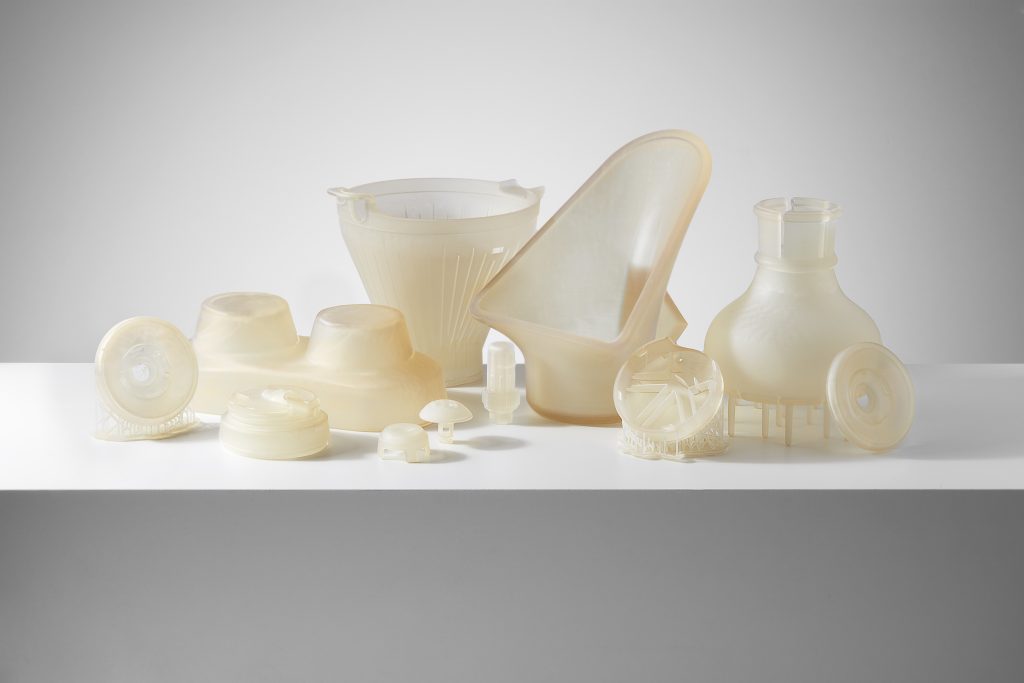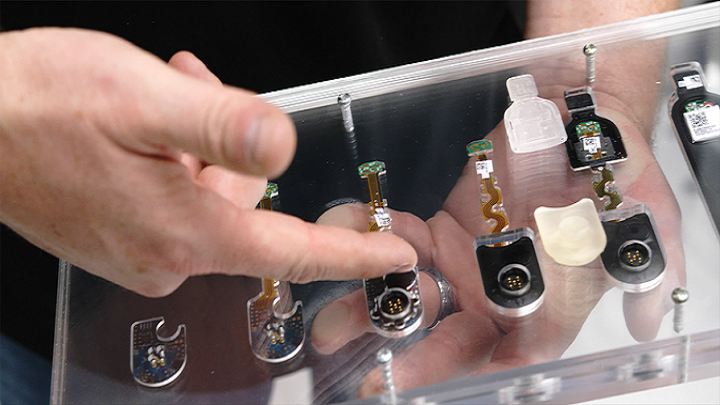Last month, Formlabs released a reformulated version of its High Temp Resin, which is part of its Engineering Resins family and features the highest heat deflection temperature (HDT) of any of its resins. The material can be used for testing, prototyping, and in production processes, which Google’s in-house technology incubator and laboratory, the Advanced Technology and Projects (ATAP) group, recently demonstrated.
The ATAP lab is a “one-stop-shop” that uses problem-solving approaches in order to realize hardware projects, and turned to Formlabs’ new and improved High Temp Resin to get around a lengthy and complex supply chain for pre-production validation of an overmolded wearable device.
Bryan Allen, a design technologist at Google ATAP who specializes in 3D printing and advanced fabrication technologies, said about the case study, “We’re not only investigating what products will look like in the future, but also what production looks like. Additive manufacturing really is a big part of that and ties in very directly with a lot of the projects that we work on.”
“I’m really excited when we can identify something new that’s going on in 3D printing, a new material, a new process, and then apply it to a project pipeline in new ways that allow something to be realized more efficiently, faster, better, or more aesthetically pleasing.”
 Overmolding is a common injection molding process which uses initial tool tuning for new parts (first articles), and ATAP was spending a lot of money completing an additional overmold over an overmolded electronic sub-assembly: a printed circuit board assembly (PCBA) with complex electronics.
Overmolding is a common injection molding process which uses initial tool tuning for new parts (first articles), and ATAP was spending a lot of money completing an additional overmold over an overmolded electronic sub-assembly: a printed circuit board assembly (PCBA) with complex electronics.
David Beardsley, the model shop manager for the Google ATAP lab, explained, “What we had was electronics that were overmolded, then overmolded again, and that gave us this flexible, waterproof object that we could use in the wearable space.”
The first articles in this project were going to be more expensive than most injection molded parts, but the team knew this going in. However, they didn’t realize that it would take nearly a month to source the necessary overmolded electronic sub-assemblies, and Google ATAP needed to find a replacement process for fabricating the PCBA that was robust, dimensionally accurate, and representative of the real sub assembly’s exact geometry.
“The light went off when I was watching dollars and weeks just going in the garbage as we were trying to figure out how to dial in the tool,” Beardsley said. “How do we prove this will work before we actually have to put live electronics in there?
“We knew we had to use a material that would withstand thousands of pounds of pressure, north of 250 °C. We were looking for high temperature resistance, high rigidity.”
Beardsley asked Allen for help, and he decided to 3D print the surrogate parts on the Form 2 using the newly reformulated High Temp Resin. This was a little risky, as the final parts would have to be injected at 270 °C with a pressure of 27,000 psi, which is pushing the boundaries of the material’s HDT.
“In order to get the small feature size and the shut-offs that we needed, we needed that resolution. It was really the combination of resolution and high temperature resistance that allowed us to use the Form 2 on this. We have the ability to select from many other fabrication technologies, but having the option to make these parts is really an important piece of our lab,” Allen explained.
The team quickly 3D printed some testing parts overnight, as they didn’t have much time to spare.
“We had no time to redo any CAD on this. I opened it, exported an STL, and threw it at the PreForm software,” Allen said. “Once we got that first batch of validation, we just cranked it. We ran 200 parts the first cycle and then we ran another 100 more.”
PreForm, which is Formlabs’ free print preparation software, can lay parts out on the Form 2 build platform in batches. This helped Allen save time by 3D printing 250 inserts in batches of 10 over four hours, so the team was ultimately able to manufacture hundreds of parts in a single weekend that ended up being perfect substitutes for Google ATAP’s electronic sub-assemblies.
“It allowed us to intercept the process further down the line and save a bunch of upfront steps,” Beardsley said. “Three or four upfront steps were just erased by doing it this way. It saved a bunch of time.”
In addition to decreasing the lead time to just three days, the cost per insert also lowered from $100 to $0.80, so the lab was able to fabricate more parts than originally planned. This enabled them to continuously run shots until they achieved good results.
“The fact that we were able to shut the tool off on 3D printed material, hit it with that high-pressure injection, and not even have it flash, that’s a bit unique,” Beardsley explained. “Had we not had the Form 2, we would not have been able to pull this off.”
Besides saving over $100,000 and lowering the turnaround time for this important component by 85%, Google ATAP came away from the experience with three very valuable lessons learned about using 3D printing in production.
- Approach each stage of development with an iterative mindset.
- Don’t silo technology: consider each machine as part of a problem-solving toolset to find the best solutions.
- Begin by solving one problem.
Additionally, the team at the lab has a newfound appreciation for Formlabs and its technology – the Form 2 3D printer and new High Temp Resin in particular.
“The truth is, the Form 2 dominates every day. Accuracy, speed, the finish, the ability to take it right off and have a finished part,” Beardsley stated. “It’s quite impressive.”
Inside Google ATAP: Bridging Pre-Production Challenges With 3D Printing | Formlabs
Discuss this story and other 3D printing topics at 3DPrintBoard.com or share your thoughts below.
[Source/Images: Formlabs]Subscribe to Our Email Newsletter
Stay up-to-date on all the latest news from the 3D printing industry and receive information and offers from third party vendors.
You May Also Like
Precision at the Microscale: UK Researchers Advance Medical Devices with BMF’s 3D Printing Tech
University of Nottingham researchers are using Boston Micro Fabrication‘s (BMF) 3D printing technology to develop medical devices that improve compatibility with human tissue. Funded by a UK grant, this project...
3D Printing Webinar and Event Roundup: April 21, 2024
It’s another busy week of webinars and events, starting with Hannover Messe in Germany and continuing with Metalcasting Congress, Chinaplas, TechBlick’s Innovation Festival, and more. Stratasys continues its advanced training...
3D Printing Webinar and Event Roundup: March 17, 2024
It’s another busy week of webinars and events, including SALMED 2024 and AM Forum in Berlin. Stratasys continues its in-person training and is offering two webinars, ASTM is holding a...
3D Printed Micro Antenna is 15% Smaller and 6X Lighter
Horizon Microtechnologies has achieved success in creating a high-frequency D-Band horn antenna through micro 3D printing. However, this achievement did not rely solely on 3D printing; it involved a combination...


































